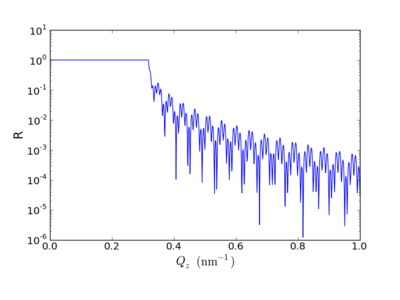Reflectivity
Reflectivity refers to the measurement of the intensity of reflection off of a flat interface. The term both describes the physical phenomenon, as well as the experimental technique.
X-ray Reflectivity (XRR or XR) and neutron reflectivity (NR) are techniques which measure the intensity of reflected radiation as a function of angle (where, by definition for specular reflectivity, the incident and exit angles are equal; ). A plot of reflectivity (R) versus angle yields the reflectivity curve. For XR and NR, the data is typically plotted as a function of the momentum transfer parallel to the film normal:
Off-Specular Reflectivity
TBD
Mathematical form
In its simplest form, the Fresnel reflectivity can be given by:
Where:
And n is the complex refractive index of the substrate. The idealized uncorrelated roughness can be characterized by a mean standard deviation of the height :
For a substrate with a single continuous layer of thickness h (e.g. a uniform thin film), the reflectivity becomes:
where
is the perpendicular component of the wave-vector (in medium j). The reflectivity coefficients are:
Where and for the vacuum-layer and layer-substrate interfaces, respectively. This is called the 'one-box model'.
Parratt formalism
TBD
- L. G. Parratt Surface Studies of Solids by Total Reflection of X-Rays Phys. Rev. 1954, 95, 359. doi: 10.1103/PhysRev.95.359
See Also
- Fresnel plot
- Oscillations below the critical angle
- DWBA: A formalism for modeling GISAXS data, including reflection effects.











